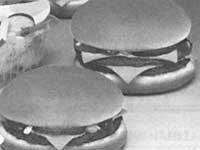Beneficial fats: oils
1998/03/01 Lorenzo, Arantza | Uranga, Ane Miren Iturria: Elhuyar aldizkaria

In general, fats are edible fats of animal or vegetable origin composed of glycerides of fatty acids. When they are liquid at 20ºC they are called oils and when they are solid at the same temperature, fats. In this section we will treat oils, trying to clarify their characteristics and peculiarities.
As you all know, the Mediterranean diet is characterized by the use of olive oil. As its own name indicates, it is an oily liquid from the olives. Unlike other vegetable oils, it can be consumed directly without refining. Olive oil is classified into two groups:
- Virgin: not refined; according to its oleic acid, we distinguish between extraordinary, fine and current. The extraordinary has a maximum acidity of 1% (one gram of oleic acid free of 100 ml of oil), the fine does not exceed 1.5% and the normal 3%. These incidents are related to the quality of the oil and not to its value as food. The most suitable for the kitchen, according to its characteristics, is 1% acidity.
- Refined: obtained through the refining process. In this process the oil is “cleaned” by eliminating impurities, so it also loses oleic acid. These are the acidity grade oils of 0.4 to 0.8% that we find in the market, depending on the oleic acid that has been left.
In addition to olive oil, we find many other vegetable seed oils on the market: sunflower, corn, soybeans, etc. All of them must be necessarily refined for consumption; their characteristics are very similar, although some have more vitamin E and the type of fat is different, as you can see in the table.
Olive oils, due to their peculiarities with respect to other vegetable oils, are frequently analyzed from a nutritional and culinary point of view. As for nutrition, as discussed above, the fats contained in the olives are monounsaturated, so they help to reduce the levels of body cholesterol and to maintain balance. This does not mean that the other oils are bad, but do not affect cholesterol so much.

In the kitchen, for its part, olive oil is much more stable than the rest against heat and does not quickly lose its physical-chemical properties, keeping it for longer. Therefore, during the cold, sunflower, for example, is immediately burned and produces irritating substances for the body. Olive oil, on the other hand, lasts longer and can be used 2 or 3 times to fry. This is our recommendation: use olive oil for frying and the rest for cooking or salads. Quantity is also a question that is often mentioned. The oil is necessary to the proper extent and it is recommended to use a total of three tablespoons per day approximately.
We want to make a special mention of coconut and palm oils, which although they are not marketed for the normal use of the kitchen, are very used for pastries for their low price and for their special pride and flavor. As for its composition, its content in saturated fats is much higher than that of the aforementioned vegetable oils, so they are less recommended. Of course, we are talking about health, because taste and tastes are totally different things and we enter them...
100 ml of oil: |
Olive oil | Sunflower sunflower | Corn Corn Maize | Soy bean production Soy bean production |
Total fat (g) |
99.90 99.90 | 99.90 99.90 | 99.90 99.90 | 99.90 99.90 |
Saturated k (g) |
12.69 12.69 | 11.79 11.79 | 14.85 | 12.60 |
k. monounsaturated (g) |
62.73 62.73 | 28.62 28.62 | 26.37 26.37 | 21.87 21.87 |
k. polyases (g) |
10.08 10.08 | 45.00 45.00 | 44.28 | 51.12 51.12 |
Vitamin E (mg) |
5.10 5.10 5.10 | 48.70 | 11.20 | 10.10 10.10 10.10 |

Gai honi buruzko eduki gehiago
Elhuyarrek garatutako teknologia






